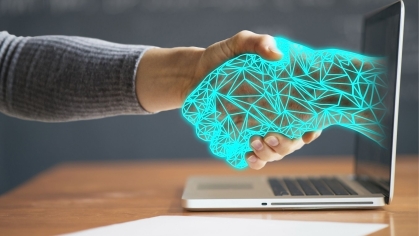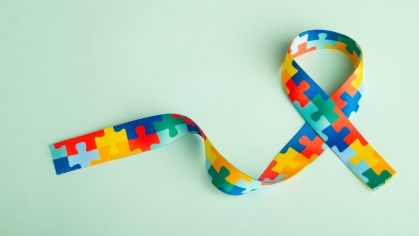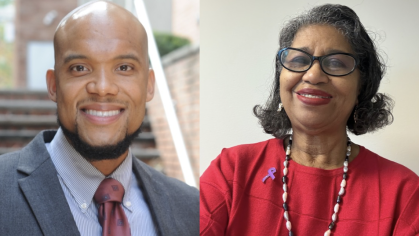Observing International Day of Persons with Disabilities: A Conversation with Ph.D. Student Rebecca Martin
International Day of Persons with Disabilities is December 3. We had the opportunity to speak with Ph.D. student Rebecca Martin about the significance of this day and what social workers can do to recognize it.
Please note that Rebecca’s responses use both person-first and identity-first language in an attempt to honor the many ways people with disabilities prefer to refer to themselves.
Tell us a bit about your journey to social work.
My career history spans customer service, management, design, and social work. The idea of social work as a profession has always spoken to me because being a social worker isn’t just about the type of work one does, but about how one views the world. I also feel that each of my other career specialties, from retail to design, aligns strongly with part of who I am and continues to define how I interact in a professional space regardless of the field or position in which I’m working.
The common threads that run through my work are a commitment to improving experiences for people – whether through thoughtful customer service, designing systems and services that ensure no one feels like their needs have been forgotten, or working to strengthen a sense of belonging for clients in the community. Now, my work is primarily to support and strengthen the skills of grantees throughout New Jersey who are working to expand disability inclusion in sustainable ways through targeting policies, systems, and environmental change. In my work now, I feel as if I am simultaneously my blue-collar customer service self, my designer self, and my social worker self, wrapped up in one. I’ve been fortunate that all of my journeys so far have led to this moment where I can be all of these selves with authenticity, doing work that has meaning to me.
I am currently a candidate in the PhD program at Rutgers School of Social Work and I’m employed as a Senior Research Specialist with the Rutgers Bloustein School of Planning and Public Policy, overseeing grant management for the Inclusive Healthy Communities grant program, funded by the NJ Division of Disability Services. I previously earned a Master of Social Work degree from Rutgers School of Social Work in Newark and a Master of Design from The Hong Kong Polytechnic University. Before that, I worked as the Visual Merchandising Manager for new and remodeling stores for Toys‘R’Us/Babies‘R’Us.
None of these things would have been possible if I had not been diagnosed with ADHD at the age of 26, when I was working in retail management, and gained access to management strategies and medication. Now, I’m just beginning to understand the role being Autistic plays in my life since my diagnosis last year. Emerging research is exploring how ADHD and Autism are often overlooked in women until adulthood, with diagnoses frequently occurring in women’s late 30s and 40s. (Barclay et al., 2024; Craddock, 2024; Sreenivas & Booth, 2024; Zener, 2019) I am certain I wouldn’t have been able to pursue a PhD if I had never received an ADHD diagnosis or received access to screen-reading software that assists me with cognitive load and processing complex materials in academic articles. My ASD diagnosis is allowing me to finally give myself grace when there are things I simply must do in my own way to be successful. Labels haven’t changed who I have been all along, but they’ve given me the ability to process my experiences and communicate with greater efficacy about what I need to be successful.
Despite the profound impact my diagnoses have had on my trajectory, I came to work in the disability field as a professional, not seeing myself as part of the disability community until much later. Looking back, I had many touchpoints that informed my empowered perspectives on the autonomy and capabilities of people with disabilities (though certainly, I still had biases that I needed to challenge, as we all do). While living in Hong Kong, a few pivotal experiences challenged my preconceived notions of disability and ultimately led to the development of the rights-based lens I currently employ: (a) taking an odd job transcribing the English proceedings of a weekend-long convening on the United Nations Convention on the Rights of Persons with Disabilities (UNCRPD); (b) doing volunteer work for a legal clinic in which a group of people with intellectual and developmental disabilities (some of whom were nonverbal) led a training for neurotypical nonprofit leaders; and (c) teaching English to a young boy who had experienced a traumatic brain injury. During my social work internships, both with the carceral system in Essex County and at a sub-acute care facility, the majority of clients’ experiences were shaped by disability. It became evident to me that people with disabilities are normal – part of the natural variation of what it is to be human – but are often treated as if they are broken. After graduation, I was offered the opportunity to work with Blind college students and those with vision impairments across New Jersey. While working with these students, I tried to research what made some colleges more successful than others in providing support and realized that there is little literature about this – nearly all of the existing disability research focused on what creates deficits, not what it looks like to thrive. I decided to return to Rutgers to pursue a PhD to change this.
What is the significance of International Day of Persons with Disabilities for you?
People with disabilities have been marginalized throughout history across cultures, and this day is significant because it asks us to celebrate the lives and contributions of people with disabilities around the globe. The International Day of Persons with Disabilities highlights that people with disabilities should have agency to create lives that align with their values and goals, and it recognizes that they contribute to society in meaningful ways. This day is not to commemorate a class of people who should be pitied but is to celebrate people who are seen as whole and perfect embodiments of what it is to be human, just as they are. The international aspect of the celebration highlights the importance of considering our intersectional positioning and how this impacts the opportunities afforded to us and the outcomes we will experience.
In the U.S., we tend to think of our nation as leading the world in advancing rights. But when it comes to disability, much of the most groundbreaking work on inclusion comes from other parts of the world. The U.S. is not a party to the United Nations Convention on the Rights of Persons with Disabilities (UNCRPD), which provides an empowered rights-based framework for nations to advance the ways in which people with disabilities should be positioned to challenge structural power imbalances that perpetuate oppression. When we, within the U.S., are exposed to how other cultures are creating positive change in how they work toward justice for people with disabilities, it helps expand our understanding of what is possible. For example, the UNCRPD includes mechanisms for ways in which disabled people, and their organizations can monitor new legislation to provide their expertise about how it will impact people with disabilities. This type of positioning could be beneficial within the U.S., where we continue to make very slow progress with important accessibility considerations due to limited oversight in anticipation of future accessibility issues and poor/limited opportunities to challenge existing violations of accessibility.
Certainly, I would be remiss if I didn’t also highlight that as we celebrate the International Day of Persons with Disabilities, so much of what we experience in the U.S. is unique among wealthy nations because we do not have a system for universal healthcare, and without it, there will never truly be disability justice here. The autonomy of people with disabilities is dependent upon the ability to manage their healthcare needs, and the privatization of these services nearly ensures discrimination and lack of equitable opportunity for people with disabilities, especially for those who are also more likely to experience oppression due to racial and LGBTQ+ identities and immigration status, among other considerations.
How can the social work community recognize and commemorate the International Day of Persons with Disabilities?
There are many days throughout the year that disability communities celebrate and are celebrated. Some celebrate the larger community, like Disability Pride Month in July, while others highlight co-occurring disabilities, such as Deafblind Awareness Week (June 24-30, 2025), or intersectional positioning, such as Jewish Disability Awareness & Inclusion Month in February. At Rutgers, we celebrate Disability Awareness in October, which is aligned with National Disability Employment Awareness Month, when many inclusion-focused events occur on campus.
Any time of year is a great time to feature the perspectives and stories of people with disabilities and to celebrate their contributions. The most important thing to consider is how these celebrations occur. We should strive to hold events that center the perspectives of people with lived experiences of disabilities rather than those of professionals or caregivers. It is important that we select holidays that are themed around the celebration of individuals, not the eradication of disease, as this indirectly communicates that creating a better world means creating a world free of disability – whereas those of us in the disability community know that creating a better world means centering our knowledge and experiences in ways that help our culture evolve to be more inclusive and expansive for everyone.
What can the social work profession or social workers do to continue to support the inclusion of people with disabilities beyond December 3rd?
As with our work with other marginalized populations, we need to start by confronting our own biases regarding:
- The right way to perform social work skills. We learn specific ways to employ clinical skills, and I have seen bias in the field toward social workers who do things differently because of disabilities (e.g., Blind therapists who may not be able to visually identify nonverbal communication or Autistic therapists who may be erroneously presumed to lack empathy). People with disabilities do not need to do things in the same ways non-disabled people do them to be effective.
- What it means to be competent to work with people with disabilities.
- I worked with a student who was turned away by both his college’s counseling center and the local therapist they referred him to because both claimed they didn’t “feel competent to work on disability.” This student had been Blind since birth and did not need to discuss his disability – he wanted therapy for other reasons. Under the Social Model of Disability, someone is disabled when they encounter an environmental or attitudinal barrier that prevents their full and meaningful participation or enjoyment of services (Bickenbach et al., 1999; Oliver, 1990; Retief & Letšosa, 2018). In this example, it’s clear that the bias of these therapists was the disabling factor, preventing care.
- That we cannot relate to the disablement someone has experienced, because we have not experienced it ourselves. When I worked with college students with vision impairments, more often than not, the life experience that I drew upon from my own life was not that of experiencing disablement, but rather of coming out as part of the LGBTQ+ community. Many of the program participants had invisible disabilities and needed to constantly negotiate who to tell and how. The parallels were useful for me when considering how to support these clients. We should not summarily assume we have not experienced something that can help us contextualize the experiences of a person with disabilities simply because we have not experienced disability ourselves.
- That we can understand someone’s capabilities better than they understand themselves.
- We often conflate the ability to communicate (verbally, “appropriately,” etc.) with capacity or worth for people with disabilities, but this cannot accurately be used to ascertain someone’s capacity or ability to participate.
- We should position each person with disabilities as an expert of their lived experience in the same way we strive to with non-disabled clients.
We should also recognize our privilege and power and use it for good. We can do this by:
- Providing objective, balanced, and full educational materials. We must understand that while we might have personal perspectives on whether clients should undertake various treatments, they deserve the autonomy to receive quality, unbiased information and to make choices for themselves. For example, you may believe ADHD is over diagnosed and children with this diagnosis are overmedicated, however the specific client in front of you may need access to medication. By influencing the parents based on your beliefs, you could be delaying that child receiving access to supports they need to be successful and healthy.
- Considering the perspectives of people with disabilities regarding whether therapies currently considered to be best practices by researchers and practitioners are ethical and beneficial. Because people with disabilities are underrepresented as researchers, research often fails to address their expressed concerns about therapies that may be harmful (Chapman & Carel, 2022; Ymous et al., 2020) When assessing the validity of research and guidance to provide to clients, consider whether it aligns with the perspectives of people with disabilities themselves. For example, ABA therapy is highly controversial, with many Autistic adults criticizing the therapy and some studies indicating that the masking behaviors it instills are linked to a higher risk of suicidal ideation for neurodivergent adults (Cernius, 2022). Despite this, it is often the only therapy insurance companies will cover for children with ASD diagnoses.
- Advocating for client autonomy. As with all clients, we should embrace interventions that allow people with disabilities to maintain the greatest degree of autonomy possible. We should work to remember that unless caregivers have disabilities themselves, they are distinct stakeholders within systems of care than people with disabilities themselves.
We should prioritize accessibility and disability advocacy in all of our work. We can do this by:
- Ensuring the materials we create are accessible.
- Reserving funds to provide accessibility supports.
- Planning with accessibility in mind – considering venue accessibility, transit options, online access, creating a welcoming environment for service animals, and especially, creating a culture that embraces differences and authenticity.
We should honor the mantra “Nothing about us without us” by:
- Ensuring that we solicit guidance from people with lived experiences of disabilities, not just when we are planning something on the theme of disability, but for every program we offer. There’s nothing we do that isn’t applicable to someone with disabilities. We should consider disability as an essential intersectional position as part of our Diversity, Equity, Inclusion, Accessibility, Justice, and Belonging (DEIAJB) initiatives.
- Recognizing that true disability inclusion means that interventions shouldn’t be targeted solely toward people with disabilities but also toward systems and people without disabilities. People without disabilities who are members of the community should adapt to accommodate people with disabilities, just as people with disabilities are expected to adapt to the majority culture. When our programs target only clients, we are saying they are broken and must conform to society. When we recognize society was built for people without disabilities and neurotypical people, we must also target our interventions toward creating structures that serve people who think, communicate, and participate differently.
- Allowing people with disabilities (as well as people from other minoritized groups) to experience the dignity of risk and failure. For persons without disabilities, having the right to self-determination means having the opportunity to define one’s own values, strive for something that is not a sure bet, and fail without that failure coming to define them. People with disabilities deserve the same rights to fail and to try again if they want to. We as social workers need to understand the importance of advocating for the fullest possible autonomy for our clients with disabilities and allowing them to have the full range of human experiences (as aligned with each individual’s values), even if that means they will sometimes fail. This is the true meaning of dignity, which we are bound to honor in all of our clients.
Barclay, I., Sayal, K., Ford, T., John, A., Taylor, M. J., Thapar, A., Langley, K., & Martin, J. (2024). Investigating the reasons behind a later or missed diagnosis of attention‐deficit/hyperactivity disorder in young people: A population cohort study. JCPP Advances, e12301. https://doi.org/10.1002/jcv2.12301
Bickenbach, J. E., Chatterji, S., Badley, E. M., & Üstün, T. B. (1999). Models of disablement, universalism and the international classification of impairments, disabilities and handicaps. Social Science & Medicine, 48(9), 1173–1187. https://doi.org/10.1016/s0277-9536(98)00441-9
Cernius, A. (2022, May 13). The autistic community is having a reckoning with ABA therapy. We should listen. [Business]. Fortune; Fortune Media USA Corporation. https://fortune.com/2022/05/13/autistic-community-reckoning-aba-therapy-rights-autism-insurance-private-equity-ariana-cernius/
Chapman, R., & Carel, H. (2022). Neurodiversity, epistemic injustice, and the good human life. Journal of Social Philosophy, 53(4), 614–631. https://doi.org/10.1111/josp.12456
Craddock, E. (2024). Being a Woman Is 100% Significant to My Experiences of Attention Deficit Hyperactivity Disorder and Autism: Exploring the Gendered Implications of an Adulthood Combined Autism and Attention Deficit Hyperactivity Disorder Diagnosis. Qualitative Health Research, 34(14), 1442–1455. https://doi.org/10.1177/10497323241253412
Oliver, M. (1990). The politics of disablement: A sociological approach. Martin’s Press. https://link.springer.com/book/10.1007/978-1-349-20895-1
Retief, M., & Letšosa, R. (2018). Models of disability: A brief overview. HTS Teologiese Studies/Theological Studies, 74(1). https://doi.org/10.4102/hts.v74i1.4738
Sreenivas, S., & Booth, S. (2024, May 21). ADHD in women [Health Information]. WebMD. https://www.webmd.com/add-adhd/adhd-in-women
Ymous, A., Spiel, K., Keyes, O., Williams, R. M., Good, J., Hornecker, E., & Bennett, C. L. (2020). “I am just terrified of my future”: Epistemic violence in disability related technology research. Extended Abstracts of the 2020 CHI Conference on Human Factors in Computing Systems, 1–16. https://doi.org/10.1145/3334480.3381828
Zener, D. (2019). Journey to diagnosis for women with autism. Advances in Autism, 5(1), 2–13.
This story was created in partnership with Rutgers School of Social Work's Inclusion, Intersectionality, Diversity, Equity, and Advancement (IIDEA) Committee.



